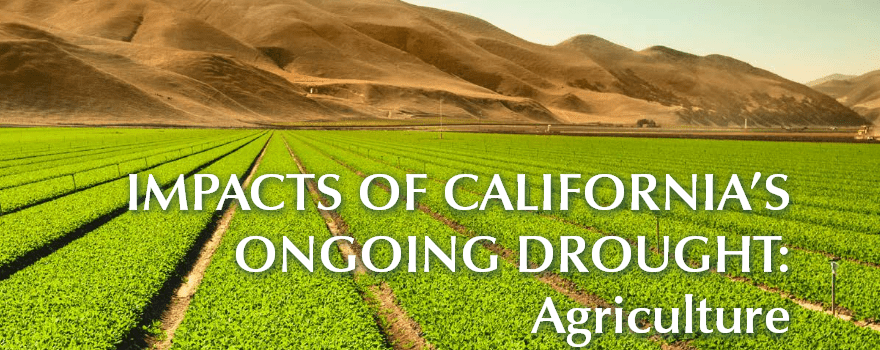“California’s agriculture sector has exceeded expectations during the most severe drought in recorded history at the cost of massive but unsustainable groundwater pumping. Continued groundwater overdraft, while reducing the economic impacts of the drought for the agricultural sector now, has shifted the burden to others, including current and future generations forced to dig deeper wells, find alternative drinking water sources, and repair infrastructure damaged by subsidence. That is the conclusion of the new study, Impacts of California’s Ongoing Drought: Agriculture, released today by the Pacific Institute, an independent global water think tank.
This new study is the first comprehensive analysis of the actual impacts of the drought on California agricultural revenue and employment through 2014 – the last year for which data are available. The study, drawing on data from the USDA National Agricultural Statistics Survey and the California Employment Development Department, analyzes acreage, revenue, and employment figures from 2000-2014.
Production costs, impacts on animal or nursery products, or regional impacts are not examined because these data are not yet available. The study’s results provide critical insight into how the state can maintain a healthy agriculture sector in a future likely to see less water, more extreme weather, and greater uncertainty.
California remains the largest agricultural producer in the U.S. in total output and in exports. During the drought, California’s agriculture sector has experienced record-high crop revenue and employment. Last year farmers harvested 640,000 fewer acres, which was 9 percent below pre-drought levels, yet crop revenue remained strong. Indeed, crop revenue peaked in 2013 at $34 billion – the highest level in California history. In 2014, crop revenue declined by $480,000 million, representing a 1.4 percent reduction from 2013 levels. All economic estimates have been corrected for inflation. Statewide agriculture-related jobs also reached a record-high of 417,000 people in 2014, highlighting the sector’s ability to withstand the reduction of available water.
The overall resilience of the state’s agricultural sector conceals some important negative local impacts. While state crop revenue and employment remain high, there are winners and losers. The study highlights that crop production was buffered through extensive and unsustainable overdraft of groundwater. Although detailed county-level acreage and revenue data are not yet available, the drought is likely having its largest impact on local economies in areas with extensive fallowing. Fallowing has reduced farm jobs in those areas, and while some may have found work elsewhere, others have not.
Heather Cooley, the study’s lead author and Water Program Director at the Pacific Institute, notes that “California farmers have implemented a range of strategies to adapt to persistent drought conditions. But while some strategies have increased their resilience, others are clearly unsustainable.”
Farms also have adopted more efficient water management technologies and practices, such as drip irrigation, and switching from lower to higher-value crops – helping boost revenue within the limits of available water. Finally, farmers, have sold water to other farmers growing more profitable crops, as well as to municipalities, industries, and to a limited extent, for environmental flows, further boosting agriculture revenue. The Pacific Institute estimates that voluntary sales from agriculture to non-agricultural users boosted agricultural revenue by at least $66 million in 2014, offsetting some of the losses from fallowing. Better data and more research are needed to understand the broader social and environmental impacts of these water sales.
Ultimately, California agriculture is changing in many ways to withstand the ongoing drought. The study concludes that California’s economy and job levels have not been adversely affected by the drought only through a series of responses, some of which will build resilience while others will have lasting and damaging consequences to local communities, ecosystems, and future generations. The protracted drought provides policymakers, farmers, and agriculture officials a unique and urgent opportunity to plan for and implement more sustainable water use policies and practices to support a vibrant and sustainable agriculture sector in California.
Download the full study from the Pacific Institute here.
 Get the Notebook blog by email and never miss a post!
Get the Notebook blog by email and never miss a post!
Sign up for daily emails and get all the Notebook’s aggregated and original water news content delivered to your email box by 9AM. Breaking news alerts, too. Sign me up!


